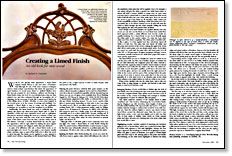
Synopsis: With its soft, ghostly white appearance, a limed finish imparts instant history to any new piece of furniture. Michael Dresdner says this look is easy to create, and the application techniques are accessible even to beginners at wood finishing. He shares tips on selecting the paint, applying the finish on either sealed or raw wood, and how to use antiquing finishes. He also talks about highlighting details, or glazing in reverse.
With its soft, ghostly white appearance, a limed finish imparts instant history to any new piece of furniture. And although it’s one of the most common techniques used to create antique reproductions that mimic the appearance of aged furniture, in recent years, limed or “pickled” finishes have also become popular for new furniture, cabinets and flooring. A limed finish creates the look of a once-finished piece that was later painted over and then redeemed through an incomplete job of stripping. For the most part, it looks like a natural wood finish, but it has telltale traces of white, off-white or even colors trapped in the wood’s pores or in the corners of carvings and moldings. Fortunately, a limed finish is easy to create, and the application techniques are accessible to even the neophyte wood finisher.
Traditionally, the limed finish was used to artificially age and darken oak (hence the often-used name “limed oak”) to make it resemble a richer and more expensive wood, such as mahogany. The process involved soaking the wood in a mixture of lime, ammonia, lye and water until the color of the wood darkened. The name of the finish comes from the lime (calcium oxide) used in this mixture. Curiously, a modern limed finish has just the opposite appearance, with its “age” added by making the piece appear to have been painted and stripped, rather than just darkened.
In spite of its affiliation with oak, a limed finish works on almost any light-color wood. You can apply a coat of paint, usually white, and then wipe or sand off the bulk of it to allow the wood to show through. The finish can be applied to a raw, stained or sealed wood surface, depending on the desired final look. When the paint is dry, a light topcoat of satin or matte lacquer seals and protects the finish.
From Fine Woodworking #79
For the full article, download the PDF below:
Fine Woodworking Recommended Products

Waterlox Original

Bumblechutes Bee’Nooba Wax

Bahco 6-Inch Card Scraper





















Log in or create an account to post a comment.
Sign up Log in